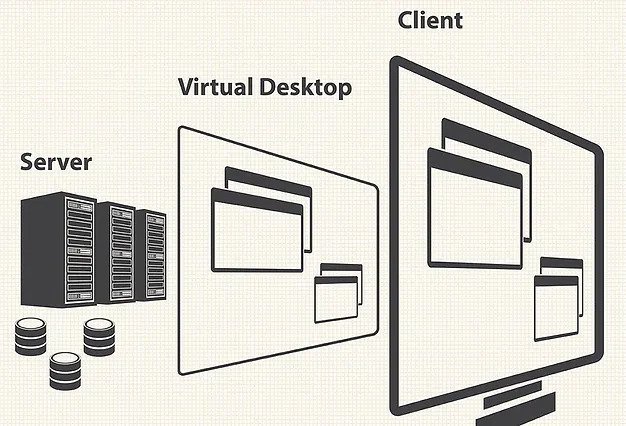
VDI Support Services In Hyderabad.
Virtual desktop infrastructure is crucial for enabling on-demand remote resource access, and Perimeter 81 helps make this idea safer and faster than ever.
What is VDI (Virtual Desktop Infrastructure)
VDI Support Services In Hyderabad.
Virtual desktop infrastructure (VDI) is an end-user computing model enabling clients to connect remotely to their desktop operating system environment through a central server, which can host multiple of these desktops for many users at once.
One of the many modes of desktop virtualization, VDI serves users with the desktop image over a network, which may be secured along with the various endpoints involved in the process: PCs, smartphones, tablets and thin client terminals.
A server hosting virtual desktops may be managed on-premises or in the cloud, and the most common type of VDI operating system available is Microsoft Windows, but there are options available via Linux and others.
From their endpoint device, the user can operate and interact with their virtual desktop as if they were sitting at the PC, and accomplish tasks on their network even from very far away and without the required resources present locally.
For this reason, virtual desktops are vital for empowering remote work and productivity.
Types of VDI
VDI can be classified as:
VDI Support Services In Hyderabad
- Persistent: This type of VDI is customized for a specific user, and the user can log in to the same desktop each time. As a result, the user can personalize the desktop for his/her needs since changes are saved even after the connection is reset
- Non-persistent: This type of VDI consists of desktops that revert to their initial state after the user logs out. Non-persistent VDI is usually simpler and cheaper since there is no need to maintain customized desktops between sessions.
How Does a Virtual Desktop Work?
VDI Support Services In Hyderabad
From the perspective of one using virtual desktop infrastructure, the experience is very similar to what they’d otherwise see on a PC: a virtual desktop screen presented on their chosen endpoint device.
However, the experience also differs somewhat in its speed – given that hardware and other resources required by desktop operations are usually closer in proximity than they would be to a local PC.
A server hosting VDI is closer to backend databases, memory repositories and storage, and more.
At the same time, interacting with the virtual desktop feels like using a local PC because the model is designed to reduce latency, compressing traffic to optimize the speed of inputs like a mouse click or typing on the keyboard.
A big clue that tells the user they’re not in a local environment is how they access their virtual desktop environment – usually by manually logging on through their local PC – though it’s possible to spin up a virtual desktop upon logging into a device.
Another way that VDI works differently is that users may not be able to save changes as they would a normal PC, but this also depends.
On a “persistent” VDI the user can make changes that will show up the next time they access the virtual desktop, but this is also more expensive and complicated to maintain.
Companies using a “non-persistent” VDI avoid these management obstacles but also limit the utility of their virtual desktops by giving users a permanently reserved (and immutable) VDI resource each time they log in.
Characteristics of VDI
VDI Support Services In Hyderabad
- Centralization: Virtual desktop infrastructure is always enabled by virtual machines on a centralized server, whether locally managed or in the cloud.
- OS Image: VDI always includes an image of a specific operating system such as Windows – the most common OS to be virtualized.
- Hosting: Because each desktop is host-based (through its server), many instances are stored and used at the same time.
- Constant Connectivity: Endpoints are unable to display a virtual desktop if they aren’t connected to the central server, so users must remain connected at all times when taking advantage of VDI.
- VDI Broker: An extra layer in the process involves what’s called a connection broker, which orchestrates the acquisition of a virtual desktop for each user when they connect, from the server’s available resources.
- Hypervisor: The hypervisor is a tool that manages the various virtual machines on the host server, and ensures that desktops accessing them have the resources they require.
WHY DO YOU GET SUPPORT FROM US?
Because We truly concentrate on the following
- Better network visibility
- Seamless integration with cloud products
- Secure, low-latency remote network access
- Instant onboarding
- Effortless scalability for growing networks
VDI Basic Components
VDI Support Services In Hyderabad
- Virtualization: Read about Virtualization here.
- Hypervisor: Learn about hypervisor here.
- Connection Broker: When a user sends a request to connect to a desktop, the Connection broker provides the user with an idle desktop instance. When a user disconnects the desktop, the Connection broker updates the status to inactive.
- Desktop Pools: These pools are a group of similar desktops that can be configured according to a specific function. For instance, departments like accounting and IT in an office might use desktops with different applications and configurations.
- Application Virtualization: VMware ThinApp is an example of Application Virtualization. These applications are the technology used to create a virtualized application image and replicate it to all the virtual desktops in a desktop pool.
Conclusion
With the help of VDI, we have more advantages and easily can connect clients remotely also can host multiple desktops for many users at once. its a safer, faster and easier.
